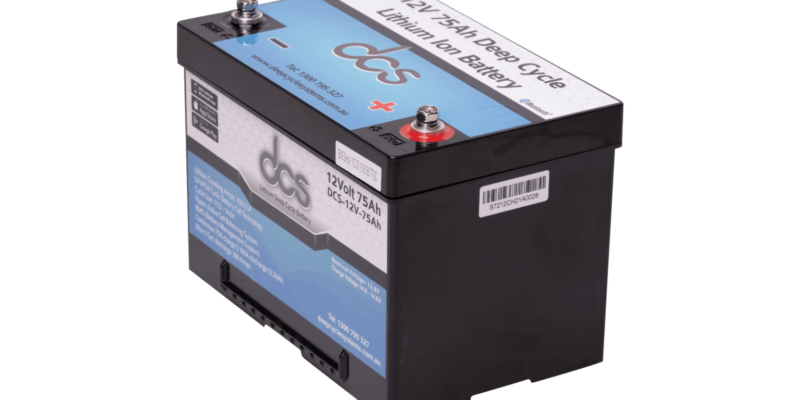
When powering your off-grid adventures or backup power needs, 120ah Deep-Cycle batteries are essential. These batteries are designed to provide a steady flow of power over an extended period, making them ideal for applications where a reliable power source is crucial. However, proper maintenance and care are essential to get the most out of your 120ah Deep-Cycle batteries. In this guide, we will explore various tips and techniques for maximising efficiency and extending the lifespan of your 120ah Deep Cycle batteries.
Maintaining 120Ah Deep-Cycle Batteries for Optimal Performance
Maintaining your 120Ah deep-cycle batteries necessitates a proactive approach, focusing on regular inspection and upkeep. Ensure the batteries are kept clean and dry to prevent corrosion and damage. Periodically, inspect the terminals for any signs of oxidation or corrosion and clean them using a mixture of bicarbonate of soda and water.
This simple act can significantly improve the electrical connection and efficiency. It’s also important to check the tightness of the terminal connections, as loose connections can lead to a loss of power and potential damage. For those using flooded lead-acid batteries, checking the electrolyte levels and topping up with distilled water is crucial to prevent the plates from being exposed to air, which can cause irreparable damage.
However, remember to wear protective gear when performing such tasks to safeguard against acid spills. Implementing these maintenance steps will enhance the performance of your 120Ah deep-cycle batteries and contribute significantly to their longevity, ensuring they remain a reliable power source for your needs.
The Importance of Regular Maintenance
Regular maintenance ensures that your 120ah Deep-Cycle batteries achieve their full potential lifespan and maintain optimal performance. It involves a systematic approach to checking and caring for the battery, which prevents unforeseen failures and enhances its reliability for your power needs.
The maintenance routine should include visual inspections for any physical damages or leaks that could indicate internal problems. Additionally, verifying the state of charge periodically helps identify any discrepancies early on, allowing for timely corrective measures. Keeping the battery terminals and connections clean and secure is vital, as poor contacts can lead to inefficient power delivery and increased strain on the battery.
While specific maintenance tasks may vary based on the type of deep cycle battery in use, the underlying principle remains the same: a well-maintained battery is more likely to deliver consistent performance and withstand the rigours of its intended application. Regular maintenance ensures the battery’s health and contributes to a more sustainable and cost-effective power solution.
Proper Charging Techniques for Maximum Efficiency
Charging your 120ah Deep-Cycle batteries correctly is paramount to maximising their lifespan and efficiency. As discussed earlier, begin by ensuring your charger is compatible with the battery’s specific needs. When charging, follow the manufacturer’s recommended settings; typically, a three-stage charging process consisting of bulk, absorption, and float stages is most beneficial.
During the bulk stage, the charger delivers a high current to the battery, up to about 80% of its capacity. The absorption stage then tops off the remaining 20%, reducing the charge current to prevent overcharging. Finally, the float stage maintains the battery at 100% charge, ready for use, without overcharging. It’s critical to never overcharge the battery, as this can lead to overheating and damage.
Conversely, undercharging can result in sulphation, which diminishes capacity and lifespan. Implement a regular charging routine, particularly after use, to avoid deep discharges beyond the recommended discharge depth, as this ca,n al, so significantly shorten the battery’s life. Adhering to these charging practices will ensure your 120ah Deep-Cycle batteries remain in peak condition, providing reliable power when needed.
The Role of Temperature in Battery Performance
Temperature plays a pivotal role in the performance and lifespan of 120ah Deep-Cycle batteries. Extreme hot and cold temperatures can adversely affect battery efficiency and durability. In hot climates or during summer, elevated temperatures can accelerate the chemical reactions inside the battery, leading to increased self-discharge rates and potential overheating.
It can cause the electrolyte to evaporate more quickly in lead-acid batteries, necessitating more frequent maintenance and potentially leading to permanent damage if left unchecked. Conversely, cold temperatures can significantly reduce the battery’s capacity to deliver power. The battery’s internal resistance increases in cold conditions, making it harder to supply the necessary current for starting or running applications.
Consequently, ensuring that your 120ah Deep-Cycle batteries are operated and stored within the manufacturer’s recommended temperature ranges is essential. Employing temperature-compensated charging, where the charge voltage adjusts according to temperature, can mitigate some of the adverse effects and aid in maintaining battery health and performance across varying climates.
Understanding the Depth of Discharge (DoD)
The Depth of Discharge (DoD) is a critical factor that directly influences the longevity of your 120ah Deep-Cycle batteries. It quantifies the percentage of the battery’s capacity that has been utilised. Operating your batteries within their recommended DoD limits is imperative to safeguard their health. Exceeding these limits can hasten the degradation process, significantly curtailing their lifespan.
Aim to use only a fraction of the battery’s total capacity for optimal results before recharging. This approach enhances durability and ensures that the batteries remain functional for a more extended period, thus providing better value for your investment.
The Significance of Proper Storage
Ensuring your 120ah Deep-Cycle batteries are correctly stored when not in use is crucial for preserving their health and extending their lifespan. Improper storage conditions can lead to many issues, such as accelerated self-discharge, sulphation, or even irreparable damage due to extreme temperatures.
Batteries should be kept in a cool, dry place, away from direct sunlight or heat sources. If possible, maintain the storage temperature within the recommended range to prevent the battery’s chemistry from deteriorating. It’s also vital to store the batteries at an appropriate charge, typically around 50-60%, and to periodically recharge them if they are to be stored for an extended period. It prevents the batteries from entering a deep discharge state, severely impacting their future performance and reliability.
Furthermore, ensuring the storage area is well-ventilated will help avoid the buildup of potentially harmful gases. By adhering to these storage principles, you can significantly minimise the risk of damage and maintain the battery’s readiness for its next use.
Selecting the Right Charger for Your Deep Cycle 120ah Battery
Choosing an appropriate charger is pivotal in preserving the integrity and prolonging the life of your Deep Cycle 120ah battery. Opt for a charger that complements the battery’s specifications, ensuring it can correctly charge at its voltage and capacity. Chargers designed for deep cycle batteries typically feature smart charging capabilities, adjusting the charge rate to prevent overcharging and undercharging, thus enhancing battery longevity.
Avoid using chargers intended for regular car batteries, as they may not cater to the specific needs of deep-cycle batteries. Selecting a charger with a maintenance mode is also beneficial. This mode can keep the battery optimally charged over prolonged periods of inactivity, thereby preventing damage and ensuring readiness for use.
Balancing Your Battery Bank for Optimal Performance
For those utilising multiple 120ah Deep-Cycle batteries in conjunction to form a battery bank, achieving a balanced state among the batteries is critical. It involves regularly checking and aligning the voltage levels across all units to prevent any single battery from overworking or undercharging.
AUtilising battery balancer can distribute the charge uniformly, ensuring each battery contributes equally to the overall system. This practice optimises and prolongs the battery bank’s lifespan, making it a vital routine for maintaining a healthy and efficient power source.
Monitoring Battery Health Regularly
Conducting frequent health checks is indispensable to safeguard the efficiency and prolong the lifespan of your 120ah Deep-Cycle batteries. It entails vigilant observation of the voltage and temperature and assessing the batteries’ performance to ensure they are functioning optimally. Utilising digiUtilisingmeters and battery monitors can provide accurate readings, facilitating early detection of potential issues.
Additionally, keeping a log of these readings over time can help identify patterns or irregularities, enabling timely intervention before significant damage occurs. This proactive approach to battery maintenance can preemptively address problems, maintaining the battery’s health and operational integrity.
The Impact of High Discharge Rates
Exposing 120ah Deep-Cycle batteries to high discharge rates can harm their health and overall performance. Such conditions impose unnecessary stress on the battery, accelerating the wear and tear and leading to a shortened lifespan. It is prudent to carefully manage the load on your batteries, avoiding scenarios where they are drained too rapidly.
For applications that consistently demand a high power output, selecting batteries with a suitable C-rating, which indicates their ability to withstand such demands, becomes essential. This approach aids in maintaining the structural integrity and functionality of your deep cycle batteries, ensuring they meet your power needs efficiently without premature decline.
Reconditioning Your 120ah Deep Cycle Battery
Reconditioning your 120ah Deep Cycle Battery involves several steps to restore its original performance. Firstly, ensure the battery is fully charged before using a battery desulfator to tackle sulphation, a common cause of reduced capacity. Follow the device instructions carefully to dislodge and dissolve the sulphate crystals.
An equalisation equalisation is necessary in some cases, as the manufacturer recommends. This process balances the battery cells and can help rejuvenate older batteries. However, it’s crucial to proceed with caution, as incorrect reconditioning can further damage the battery. Consult the battery’s manual for guidance or seek professional assistance if unsure.
Knowing When to Replace Your Battery
Even with meticulous maintenance, 120Ah deep-cycle batteries will eventually exhibit signs of ageing and reduced performance. It’s crucial to be vigilant for symptoms such as a noticeable decline in capacity, an uptick in self-discharge rates, or visible damage to the battery’s casing. These indicators suggest that the battery may no longer efficiently meet your power requirements.
Additionally, consider a replacement if you observe that the battery struggles to hold a charge or your electronic devices are not operating as long as they used to. Frequent need for reconditioning or an increase in the time required to charge the battery fully can also signal that its effective lifespan is nearing its end.
Recycling Your Old Deep Cycle Battery
When your 120ah Deep-Cycle battery reaches the end of its life, responsibly disposing of it is paramount. These batteries contain materials that, if not handled properly, can pose significant environmental risks. To mitigate this, locate a certified recycling facility or return the battery to the retailer, many of whom have established recycling programmes.
Participating in these schemes contributes to preserving our environment and ensures that the hazardous components are safely processed and repurposed. It’s a simple yet impactful step towards sustainable battery usage and management.
Investment in 120ah Deep-Cycle Battery Monitoring Systems
Investing in a sophisticated 120ah Deep-Cycle battery monitoring system is a wise decision for anyone looking to optimise and extend their batteries’ lifespan. These systems provide real-time insights into the battery’s condition, including voltage, current, temperature, and depth of discharge.
Having this information readily available lets you make informed decisions about charging, discharging, and maintenance schedules. Moreover, early detection of potential issues through monitoring can prevent damage before it becomes severe, thereby saving on costly repairs or replacements. An advanced monitoring system is invaluable in ensuring your deep cycle batteries are operating efficiently and at their full potential, making it a critical component of your battery management strategy.
Understanding Warranty and Guarantees
Navigating the warranty and guarantees provided with your 120ah Deep-Cycle batteries is crucial for protecting your investment. Manufacturers often offer a warranty period that typically ranges from one to several years, depending on the brand and model of the battery. This warranty may cover defects in materials and workmanship under normal use conditions. It is vital to thoroughly read and understand the terms and conditions of the warranty, as certain actions or misuse might void it.
Guarantees might also stipulate the battery’s expected lifespan and performance thresholds, offering replacements or refunds should the product fail to meet these criteria. Keep all purchase receipts to ensure you are fully covered, and document any maintenance or servicing performed.
Having detailed records can simplify the process and facilitate a favourable outcome in potential warranty claims. Remember, warranties and guarantees are a testament to the manufacturer’s confidence in their product and a form of consumer protection that underscores the importance of choosing reputable brands and vendors for your deep-cycle battery needs.
FAQs
What distinguishes a 120ah Deep-Cycle battery from other types?
A 120Ah deep-cycle battery is designed for long, sustained discharges. It can be drained and recharged many times, making it ideal for solar energy systems, motorhomes, and marine applications.
Can I use a car charger to charge my 120ah Deep-Cycle battery?
It’s not advisable to use a car charger for a deep-cycle battery, as they are designed for shallow charges. Opt for a charger specifically made for deep-cycle batteries to ensure proper charging and longevity.
How often should I perform maintenance checks on my 120ah Deep-Cycle battery?
Regular maintenance checks should be performed at least every three months. However, frequent usage or harsh conditions may necessitate more frequent checks.
Can I overcharge a 120ah Deep-Cycle battery?
Yes, overcharging can lead to overheating and potentially damage the battery. Use a smart charger that stops charging once the battery is full to prevent overcharging.
Conclusion
Adhering to the guidance provided, from maintaining optimal charging practices to monitoring your batteries’ health. It ensures the enduring efficacy and longevity of your 120ah Deep Cycle batteries. Proper care, regular checks, and informed usage are pivotal in leveraging the full potential of these batteries. Guaranteeing a steady and reliable energy source for your requirements. Embrace these strategies diligently, and investing in deep-cycle batteries will deliver substantial, lasting benefits.









